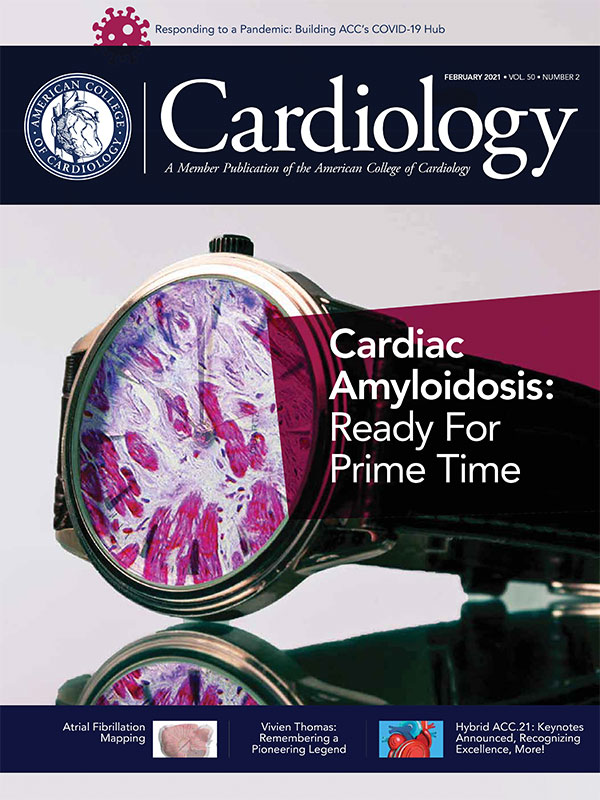Quality Improvement For Institutions | Reflecting on Quality Improvement and NCDR Success

Two decades ago, a national quality movement was triggered with the publication of two seminal documents on patient safety and quality in the U.S. health care system. The Institute of Medicine (IOM), now the National Academy of Medicine (NAM), released its landmark report, Crossing the Quality Chasm: A New Health System for the 21st Century, following on the 2000 IOM report, To Err is Human: Building a Safer Health System.
The Quality Chasm anniversary was marked with a series of four viewpoints in the Journal of the American Medical Association (JAMA) that reflected on progress made and explored priorities for quality improvement (QI) over the next 20 years.
The ACC was already a leader in the QI movement – and had launched the first NCDR program, the CathPCI Registry in 1997 – when the Quality Chasm report published.
The NCDR's primary focus was helping individual hospitals measure and improve cardiovascular care by applying clinical data. Data were rarely used or shared beyond the participating hospital or the ACC. There was skepticism that "data collection and benchmarking could lead to improved hospital performance and better patient outcomes," ACC President Athena Poppas, MD, FACC, and Frederick Masoudi, MD, MSPH, FACC, NCDR chief scientific adviser and chair of the NCDR Oversight Committee, write in a Leadership Page in the Journal of the American College of Cardiology.1 Yet, since then, NCDR data have been used to decrease door-to-balloon times, control costs associated with preventable procedural complications, reduced PCI-associated bleeding risks and more, Poppas and Masoudi add.
The Quality Chasm report identified six focus areas for QI: patient safety, care effectiveness, patient-centeredness, timeliness, efficiency and equity. The report "galvanized a new culture of quality and safety in U.S. health care," Victor J. Dzau, MD, FACC, NAM president, and Kenneth I. Shine, MD, FACC, IOM president from 1992 to 2002, write in a JAMA viewpoint marking the anniversary.2 In the early 2000s, groups like the Institute for Healthcare Improvement, National Committee for Quality Assurance, National Quality Forum, and the federal Agency for Healthcare Research and Quality developed strategies and action plans addressing the six focus areas, with the overall goal of improving quality of care delivery.
As the QI movement gained traction, participation grew in the CathPCI Registry, providing them with data on adherence to ACC/AHA clinical practice guidelines and procedure performance standards. Now armed with data, participants had the information to assess quality at their institutions, identify potential performance improvement areas and monitor progress.
NCDR's reach expanded, with additional registries addressing new clinical areas, including acute myocardial infarction (AMI), ICD implantation, lower extremity peripheral vascular interventions, atrial fibrillation ablation, TAVR, left atrial appendage occlusion procedures, and pediatric and adult treatment of adult congenital heart disease, as well as outpatient care for cardiovascular conditions.
The registries were complemented by ACC's quality campaigns, which used registry data to drive QI. Tied to the Chest Pain – MI Registry, the Patient Navigator Program: Focus MI focused on safety, effectiveness and efficiency, helping hospitals implement evidence-based practices to improve care and outcomes for AMI patients and reduce avoidable readmissions.
ACC's Reduce the Risk: PCI Bleed campaign leverages the CathPCI Registry to minimize PCI-associated bleeding risks and save patient lives through adoption of evidence-based best practices.
Engaging the Community: Public Reporting
While data are critical, achieving QI requires looking beyond metrics. "Evidence continuously mounts of the importance of patient and community engagement in achieving better individual and population-based outcomes. Greater transparency and accountability about the performance of health systems also appear to help," Sheila Leatherman, MSW, professor at the Gillings School of Global Public Health at University of North Carolina, Chapel Hill, and Donald M. Berwick, MD, MPP, president emeritus and senior fellow at the Institute for Healthcare Improvement, note in one of the JAMA viewpoints.3
NCDR engages with participating hospitals through ACC's public reporting program, which provides participating facilities with the opportunity to publicly showcase their commitment to continuous QI and a more transparent health care system. Participation in the program enables the public to view a hospital's performance on selected registry measures via the Find Your Heart a Home tool on ACC's CardioSmart website, a patient-facing tool designed to emphasize the value of the patient and clinician partnership to personalize care. Patients, caregivers and others can search Find Your Heart a Home based on location, hospital name or services, empowering patients to make informed choices based on the quality of care provided in their area.
Leading With Outpatient Registry Data
Most national patient safety and quality efforts are focused on inpatient settings. The "time to accelerate initiatives to reduce preventable harm in outpatient settings has arrived,"4 Hardeep Singh, MD, MPH, chief of the Health Policy, Quality and Informatics Program, Center for Innovations in Quality, Effectiveness and Safety at the Michael E. DeBakey VA Medical Center in Houston, TX, and Pascale Carayon, PhD, director of the Wisconsin Institute for Healthcare Systems Engineering at the University of Wisconsin-Madison, write in another JAMA viewpoint.
NCDR was also on the forefront with the outpatient PINNACLE Registry, now operating in partnership with Veradigm. Launched in 2008, the PINNACLE Registry is the largest outpatient cardiovascular registry, capturing data on coronary artery disease, hypertension, heart failure and atrial fibrillation. Over the last decade, it has been used to meet federal quality reporting requirements under the Quality Payment Program.
As ambulatory surgery centers have begun performing PCI procedures, the CathPCI Registry and ACC's Cardiac Cath Lab Accreditation are specifically designed to support teams in either setting as they strive to achieve quality and process improvement goals and enhance patient outcomes.
The Road Ahead: The Next 20 Years
In the past year, the COVID-19 pandemic has presented several challenges across the health care system. As the system recovers from the pandemic, "quality must remain a central focus," Dzau and Shine write in JAMA.
Quality firmly remains the backbone of the NCDR. The College and NCDR leaders have identified four specific objectives for continued success of NCDR programs in a rapidly changing health care system: 1) reducing the burden of data collection while exploring additional sources of data; 2) enhancing NCDR value to stakeholders; 3) promoting local, regional, national and international QI; and 4) supporting population health management through advocacy and generalizable information. As hospitals and practices continue to address challenges related to COVID-19, reducing the effort required for NCDR participation is particularly important. In collaboration with the health care analytics company Carta Healthcare, the ACC is bringing an artificial intelligence solution to assist hospitals participating in NCDR to alleviate the strain on time and resources that high-quality data collection and submission requires, allowing clinicians to return their focus to their patients.
"It is our professional responsibility to help hospitals, health systems, and practices, along with the physicians and nurses, optimize cardiovascular care and outcomes both now and into the future," Poppas and Masoudi write in JACC. "The NCDR has held these answers and is committed to adapting to changes in the health care and technological environments to remain a leader in ensuring that the right care is delivered to the right patient at the right time."
References
- Poppas A, Masoudi F. NCDR: Advancing patient care, outcomes, and value through innovation and knowledge. J Am Coll Cardiol 2021;77:224-6.
- Dzau VJ, Shine KI. Two decades since to err is human: Progress but still a "chasm." JAMA 2020;324:2489-90.
- Leatherman S, Berwick DM. Accelerating global improvements in health care quality. JAMA 2020;324:2479-80.
- Singh H, Carayon P. A roadmap to advance patient safety in ambulatory care. JAMA 2020;324:2481-2.
Clinical Topics: Arrhythmias and Clinical EP, Cardiovascular Care Team, COVID-19 Hub, Heart Failure and Cardiomyopathies, Invasive Cardiovascular Angiography and Intervention, Prevention, Atherosclerotic Disease (CAD/PAD), Atrial Fibrillation/Supraventricular Arrhythmias, Acute Heart Failure, Interventions and Coronary Artery Disease, Hypertension
Keywords: ACC Publications, Cardiology Magazine, Accreditation, Ambulatory Surgical Procedures, American Medical Association, Anniversaries and Special Events, Artificial Intelligence, Atrial Fibrillation, Benchmarking, Caregivers, CathPCI Registry, CathPCI Registry, Chest Pain, Coronary Artery Disease, COVID-19, Data Collection, Delivery of Health Care, Evidence-Based Practice, Goals, Government Programs, Government Programs, Health Policy, Health Services Research, Heart Failure, Hospitals, Hypertension, Informatics, Inpatients, Leadership, Longitudinal Studies, National Academy of Sciences, U.S., National Cardiovascular Data Registries, Outpatients, Pandemics, Patient Navigation, Patient Readmission, Patient Safety, Percutaneous Coronary Intervention, Public Health, Quality Improvement, Registries, Chest Pain MI Registry, Schools, Social Responsibility, United States Agency for Healthcare Research and Quality, Universities
< Back to Listings

